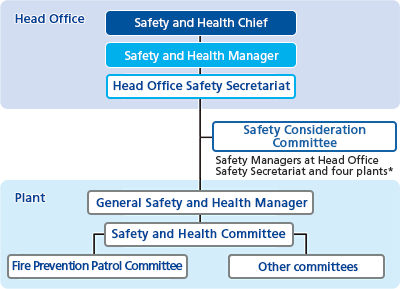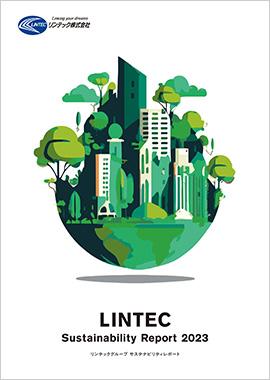- Small
- Large
Together with Employees (Safety and Disaster Prevention)
The LINTEC Group continues to operate the Occupational Safety and Health Policy, which it established based on ISO 45001★. According to the policy, annual safety and health plans are developed. Relevant activities are carried out in accordance with the plans, which set targets and specific activities for individual priority actions. Activity results are evaluated by way of internal audit and management review to assist activities in the following fiscal year.
- ★ISO 45001: International standard for occupational health and safety management systems.
Occupational Safety
Occupational Safety and Health Policy
In 2018, the LINTEC Group established the LINTEC Occupational Safety and Health Policy and revised the LINTEC Occupational Safety and Health Manual in conformity with the ISO 45001★ standard.
Each plant creates an annual safety and health plan every year based on the Plant Safety and Health Policy and carries out activities according to the plan. The activity status is checked by the Safety and Health Committee and mutual audit, and is also subjected to management review.
The Safety and Health Management System has been established, and the Safety and Health Committee and the Health Committee each hold a monthly meeting. Employee representatives attend these meetings to consult with employer representatives on issues related to safety and health. Proceedings are prepared for each meeting in order to share the results of the consultation sessions with other employees.
Also, internal audits are performed with employees at eight plants in Japan, the Research & Development Division, TOKYO LINTEC KAKO, INC., and representatives of partner companies assigned to work full-time at these sites.
LINTEC created a program for “Creating a Culture of Safety and Health” to provide an easy-to-understand guide to its safety and health activities. Using this, and based on the Four LINTEC Safety Principles, we will promote the four pillars of safety and health activities to foster LINTEC’s safety and health culture.
- ★ISO 45001: International standard for occupational health and safety management systems.
- LINTEC Occupational Safety and Health Policy
- Overview of the LINTEC Occupational Safety and Health Manual
LINTEC Safety and Health Management System (excluding the head office and sales division)

- ★Four plants: Agatsuma, Kumagaya, Tastuno, and Mishima.
Creating culture of safety and health at LINTEC
Slide to view.

Annual Safety and Health Plans
Each fiscal year, the LINTEC Group formulates annual plans for safety and health activities. The plans indicate top management policies and set priority action items to realize the policies, including safety patrols, risk assessment★, and safety education. More specific activities and targets are set for the priority action items and are reflected in safety and health activities. The results of activities and the progress are reported in the monthly Safety and Health Committee meetings, and all members of the Committee engage in discussions on improvement. By implementing such PDCA cycles that lead to the next round of initiatives, the LINTEC Group continues to step up its safety and health activities.
- ★Risk assessment: Evaluating risks to set safety standards.
Annual Safety and Health Plan
- Meetings of the Safety and Health Committee
- Patrols
- Risk assessment safety education
- Training plan
- Inspection planning
- Measurement of work environment conditions
- Medical checkups
- Mental health
- Internal audit
- Management review, etc.
In cooperation with the Tokyo Stationery Industry Health Insurance Society, which LINTEC belongs to, the company holds periodic medical checkups. Based on the analysis of the results, each site offers follow-up testing and personal health guidance to employees if necessary.
We have established a system that provides all employees with opportunities to obtain mental health checkups conducted by HOKENDOHJINSHA Inc., and offers online services for physical and mental health consultation.
Safety and Health Committee and Health Committee
Every month, the LINTEC Group plants and research centers in and outside Japan hold Safety and Health Committee meetings, while the Head Office, Bunkyo Kasuga Office, Osaka Branch Office, and other business sites having sales departments convene Health Committee meetings. Each of these meetings are attended by representatives of the labor union.
Matters concerning overall safety and health, including statutory matters, are discussed by the committees, and we make it a rule to seek employee input. Regarding the outcomes of the committee meetings, the head of each site has the responsibility and authority to make the final decision. Thus, the company ensures full representation of employees in committee meetings.
After Safety and Health Committee and Health Committee meetings conducted at each business site, employees’ opinions submitted at these events are recorded in the proceedings, and relevant information is communicated to all employees.
Committees on workplace safety and health
Slide to view.
| Committee | Invitees | Activities |
|---|---|---|
| Safety and Health Committee | Plants, Research Center |
|
| Health Committee | Head Office and business sites having sales departments |
|
Protection Against High-incidence / High-risk Diseases Related to Work Duties
Recognizing that the LINTEC Group’s business unavoidably involves work duties posing a high risk of causing disease, we have established a structure to prevent such risks. At worksites where organic solvents are used, for instance, an organic solvent work chief is appointed to provide appropriate work instructions, and the work environment is periodically monitored. Related workers are required to receive a special health examination in addition to the standard medical checkup.
Measures have been developed for various other special duties carrying high health risks, such as employing legally qualified workers, installing protective equipment, and offering special health examinations.
Toward Zero Accidents Resulting in Absence from Work
In fiscal 2022, there were two lost-time accidents due to being caught between objects, and one each due to falling on the floor and falling from a step stool.
Occurrence of accidents resulting in absence from work
Slide to view.
| FY2019 | FY2020 | FY2021 | FY2022 | |
|---|---|---|---|---|
| Number of deaths (person) | 0 | 0 | 0 | 0 |
| Number of accidents resulting in absence from work | 4 | 1 | 2 | 4 |
| Number of days of absence from work | 315 | 3 | 52 | 91 |
| Accident frequency rate★1 | 0.75 | 0.19 | 0.37 | 0.76 |
| Accident severity rate★2 |
0.0488 | 0.0005 | 0.0078 | 0.0142 |
| Location of accidents | LINTEC CORPORATION,
Partner companies |
Partner companies | LINTEC CORPORATION | LINTEC CORPORATION, Partner companies |
The company identifies hazards (potential risk factors for serious damage) through risk assessment programs. Regarding the accident that occurred in fiscal 2022, no such factors were identified from risk assessment results.
★ For detailed data, click here.
- ★1Frequency rate: The number of deaths and injuries due to industrial accidents per million hours actually worked, indicating the frequency of accident occurrence.
- ★2Severity rate: The number of workdays lost per 1,000 hours actually worked, indicating accident severity.
One Million Accident-free Hours Achieved
In fiscal 2022, the following plants set milestone records for accident-free hours: 3.5 million hours at the Kumagaya Plant in June, 2.5 million hours at the Mishima Plant in September, 1.5 million hours at the Ina Technology Center in November, and one million hours at the Agatsuma Plant in December.
Fiscal 2022 accident-free hours achievements
Five sites, namely, the Agatsuma Plant, Chiba Plant, Shingu Plant (including Niihama), Komatsushima Plant, and Research Center, were accident-free in fiscal 2022.
Regular Safety Council Meeting (Kumagaya Plant)
With the aim of preventing on-site accidents involving construction contractors, the Kumagaya Plant holds a periodic safety conference three times a year, inviting representatives of the contractors. In fiscal 2022, in response to the COVID-19 situation, we made changes to the conference plan in order to run the relevant programs. Specifically, the in-person meetings scheduled at the plant were cancelled, and instead written materials were sent to each company to ask for implementation of appropriate measures to ensure on-site safety and COVID-19 outbreak control. Similar steps were taken at other plants, where in-person meetings were cancelled, documents were sent to contractors to promote their awareness, and training was provided within individual companies.
The Plant performs periodic risk assessments in order to identify and eliminate hazardous factors and minimize risks, as well as conducting ad hoc assessments in times of emergency, for the installation of equipment, and for other events.
Fiscal 2022 Construction Safety Conferences
In fiscal 2022, in response to the COVID-19 situation, we made changes to conference plans in order to run the relevant programs, specifically cancelling in-person meetings, sending documents to contractors to promote their awareness, and providing training within individual companies.
Top Management Patrols at Production Bases
In fiscal 2022, the president’s top management patrol was cancelled due to the COVID-19 pandemic. It will be reinstated in fiscal 2023. LINTEC will enhance risk assessment, continue to take improvement measures for safety-related issues, and make efforts to completely eliminate accidents at each site.
Disaster Control in BCMS★1
For disaster prevention and mitigation, the LINTEC Group practices group-wide BCMS activities based on ISO 22301★2, and conducts risk assessments, placing top priority on saving human lives. All LINTEC sites examine their operations and facilities to identify, analyze and assess risks of damage that may be caused by different types of disasters. It is stipulated in the corporate-wide BCMS activity rules that if it is found that disaster control in a site is not sufficient, the site should plan and take sufficient measures. Moreover, the concreteness and validity of these disaster control measures are checked and improved by carrying out disaster drills.
- ★1BCMS: BCMS stands for a Business Continuity Management System. It is a management technique to develop a business continuity plan, based on the understanding of the current conditions of the organization, to ensure that the businesses are continued in the event of a serious incident that will or may have grave impact on major products/services of the organization. Drills are also performed to validate the effectiveness of the BCP.
- ★2ISO 22301: An international standard for BCMS that a corporation or organization should follow in establishing and effectively operating a system to prepare for earthquake, fire, trouble in the IT system, financial crisis, bankruptcy of supplier, pandemic, or other natural disaster or accident.
- Message from the President
- Concept and Systems
- Highlight: Initiatives for the Reduction of CO2 Emissions
- Environmental Report
- Environmental Management System
- Developing Environmentally Friendly Products
- Climate Change Mitigation and Adaptation
- Realization of a Recycling-oriented Society
- Co-existence with Nature
- Management of Environmentally Hazardous Substances
- Environmental Accounting
- Environmental Data of Group Companies Outside Japan
- Relationship between LINTEC and the Environment
- Social Report
- Providing Value to Customers
- Cooperating with Suppliers
- Together with Employees (Human Rights / Employment)
- Together with Employees (Human Resource Development)
- Together with Employees (Safety and Disaster Prevention)
- Together with Local Communities
- Together with Shareholders
- Communicating with Stakeholders
- Governance Report
- SDGs-related Initiatives
- CSR Activities at Group Companies Inside and Outside of Japan
- Information Disclosure Based on TCFD Recommendations
- Corporate Policies
- Reporting Policy
- Performance Data
- GRI Index
- Message from Outside Director
- Third-Party Verification
- External Evaluations
- Download Report

